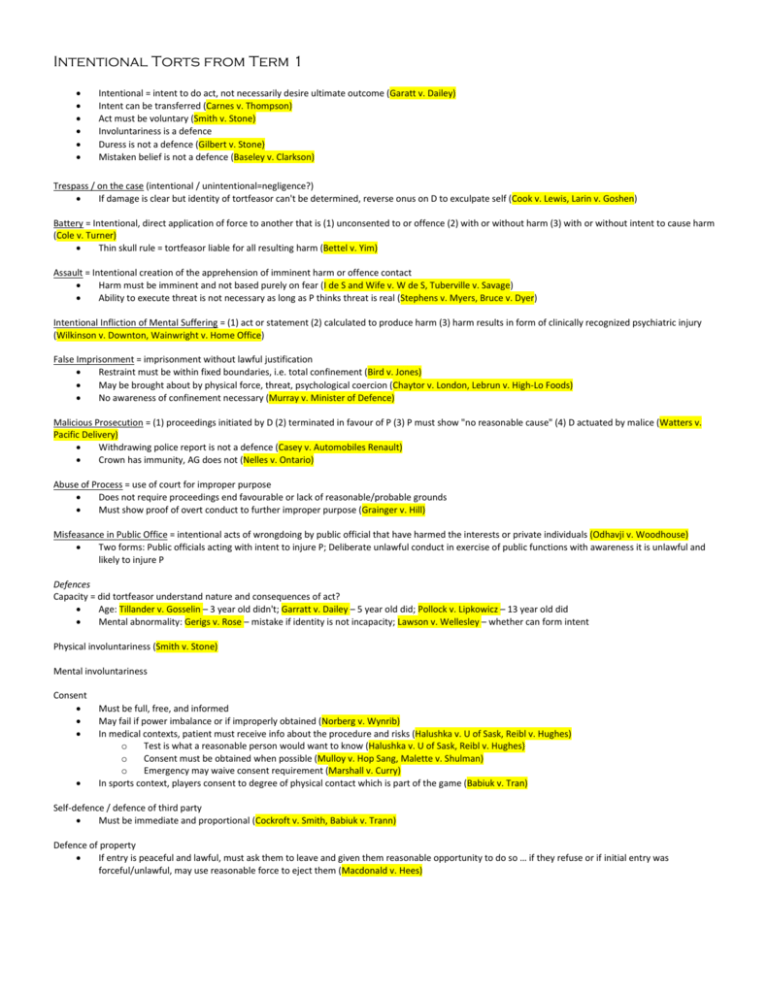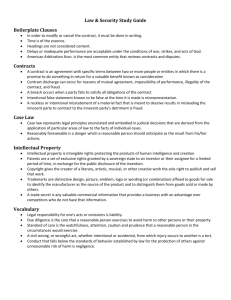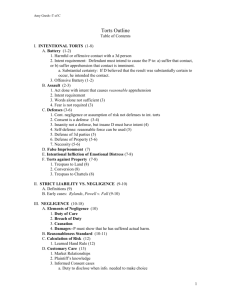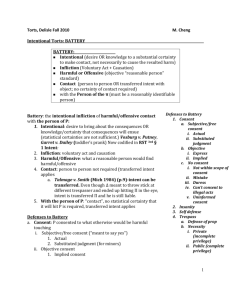Law-140-Torts-term-2
advertisement

Intentional Torts from Term 1 Intentional = intent to do act, not necessarily desire ultimate outcome (Garatt v. Dailey) Intent can be transferred (Carnes v. Thompson) Act must be voluntary (Smith v. Stone) Involuntariness is a defence Duress is not a defence (Gilbert v. Stone) Mistaken belief is not a defence (Baseley v. Clarkson) Trespass / on the case (intentional / unintentional=negligence?) If damage is clear but identity of tortfeasor can't be determined, reverse onus on D to exculpate self (Cook v. Lewis, Larin v. Goshen) Battery = Intentional, direct application of force to another that is (1) unconsented to or offence (2) with or without harm (3) with or without intent to cause harm (Cole v. Turner) Thin skull rule = tortfeasor liable for all resulting harm (Bettel v. Yim) Assault = Intentional creation of the apprehension of imminent harm or offence contact Harm must be imminent and not based purely on fear (I de S and Wife v. W de S, Tuberville v. Savage) Ability to execute threat is not necessary as long as P thinks threat is real (Stephens v. Myers, Bruce v. Dyer) Intentional Infliction of Mental Suffering = (1) act or statement (2) calculated to produce harm (3) harm results in form of clinically recognized psychiatric injury (Wilkinson v. Downton, Wainwright v. Home Office) False Imprisonment = imprisonment without lawful justification Restraint must be within fixed boundaries, i.e. total confinement (Bird v. Jones) May be brought about by physical force, threat, psychological coercion (Chaytor v. London, Lebrun v. High-Lo Foods) No awareness of confinement necessary (Murray v. Minister of Defence) Malicious Prosecution = (1) proceedings initiated by D (2) terminated in favour of P (3) P must show "no reasonable cause" (4) D actuated by malice (Watters v. Pacific Delivery) Withdrawing police report is not a defence (Casey v. Automobiles Renault) Crown has immunity, AG does not (Nelles v. Ontario) Abuse of Process = use of court for improper purpose Does not require proceedings end favourable or lack of reasonable/probable grounds Must show proof of overt conduct to further improper purpose (Grainger v. Hill) Misfeasance in Public Office = intentional acts of wrongdoing by public official that have harmed the interests or private individuals (Odhavji v. Woodhouse) Two forms: Public officials acting with intent to injure P; Deliberate unlawful conduct in exercise of public functions with awareness it is unlawful and likely to injure P Defences Capacity = did tortfeasor understand nature and consequences of act? Age: Tillander v. Gosselin – 3 year old didn't; Garratt v. Dailey – 5 year old did; Pollock v. Lipkowicz – 13 year old did Mental abnormality: Gerigs v. Rose – mistake if identity is not incapacity; Lawson v. Wellesley – whether can form intent Physical involuntariness (Smith v. Stone) Mental involuntariness Consent Must be full, free, and informed May fail if power imbalance or if improperly obtained (Norberg v. Wynrib) In medical contexts, patient must receive info about the procedure and risks (Halushka v. U of Sask, Reibl v. Hughes) o Test is what a reasonable person would want to know (Halushka v. U of Sask, Reibl v. Hughes) o Consent must be obtained when possible (Mulloy v. Hop Sang, Malette v. Shulman) o Emergency may waive consent requirement (Marshall v. Curry) In sports context, players consent to degree of physical contact which is part of the game (Babiuk v. Tran) Self-defence / defence of third party Must be immediate and proportional (Cockroft v. Smith, Babiuk v. Trann) Defence of property If entry is peaceful and lawful, must ask them to leave and given them reasonable opportunity to do so … if they refuse or if initial entry was forceful/unlawful, may use reasonable force to eject them (Macdonald v. Hees) Intentional Torts from Term 2a Chattels are any tangible personal property other than real property Title = ownership; possession – physical control; bailment = holding for someone else; right to immediate possession = demand chattel to be delivered up Trespass (Chattels) = intentional direct, physical interference with chattel of which P has right to possession Does not require intention to harm or awareness of P's right to possession, just intention to do act Unclear whether there is liability without damages Detinue (Chattels) = wrongful failure or refusal by D to deliver chattel up on demand when P has right to immediate possession Conversion (Chattels) = wilful interference, without lawful justification, with chattel in manner inconsistent with P's right to possession; whereby P is deprived of use and possession of chattel Innocent third party may be liable for conversion (Canlab v. Engelhard, Hollins v. Fowler) Right to possession is relative (Armory v. Delarmie) Calculating damages is based on losses that D caused to P by excluding P from possession of chattel May be less than value at time of conversion (e.g. P got it back, chattel would've perished anyways) … or may be more (e.g. P incurred additional expenses while not in possession or while getting chattel back – Kuwait Airways v. Iraqi Airways) Defamation is a false statement about someone to their discredit Intent to defame is not required (Yousoupoff,, E. Hulton v. Jones) Knowledge of person or their existence is not required (E. Hulton v. Jones) Motive or reasonable belief is not important (E. Hulton v. Jones) Reputation of groups is not protected by defamation law (Gauthier v. Toronto Star) Tort is not inconsistent with Charter rights (Hill v. Church of Scientology) Slander = print/written or recorded defamation in some permanent form To succeed, do not have to show damages Libel = verbal statements To succeed, must show special damages (Conyd v. Brekelmans) Absolute liability for repeating or distributing libel … strict liability for publishing; can be held not liable if you can disclaim knowledge or show you weren't negligent or at fault (Vizetelly v. Mudie's Select Library) Defences Absolute privilege (e.g. Parliamentary privilege) Qualified privilege = statement made by individual with an interest/duty to another who has a corresponding interest/duty to receive it Statement must have been made without malice; onus on P to prove malice (Cusson v. Quan) Fair comment = opinion based in fact, made in good faith and in public interest Facts upon which opinion is based must be correct Opinion does not have to be "reasonable", just something that someone could believe (WIC Radio v. Simpson) Public Nuisance = conduct of the D which unreasonably and substantially interferes with all members of the community or class that comes within sphere of neighbourhood/sphere of its operation Civil actions can be brought by AG representing the public OR private person Private person must show his private rights are affected OR that there is "special/peculiar" damage to him (Stein v. Gonzales) Private Nuisance = conduct of the D which unreasonably and substantially interferes with P's use of his land Same conduct may be both a public and private nuisance (Sutherland v. AG) Nuisance is not measured on a standard of reasonableness of use; any use may qualify (Russell Transport v. Ontario Malleable Iron) Liability for nuisance will not be imposed if activity complained of is authorized by statute and D can prove the nuisance is the "inevitable result" or consequence of exercising that authority (Sutherland v. AG) Non-defences for nuisance P came to nuisance P injures P but is beneficial to the public at large Place is suitable for operation and no other place is available All possible care and skill is being taken Others acting independently of D, doing the same thing, would not amount to nuisance D is making reasonable use of his property Strict Liability = if D brings or accumulates on his land something that is harmless while it remains there, but will naturally cause mischief if it escapes, he will do so at his peril (Rylands v. Fletcher) D will be prima facie answerable for all damage that is consequence of its escape May only excuse himself by showing the escape was an act of God Limited by statute, insurance (Transco plc v. Stockport) Negligence Duty of Care "Neighbour principle" establishes that "you must take reasonable care to avoid acts or omissions that you can reasonably foresee would be likely to injure your neighbour" (Donoghue v. Stevenson) Harm must be foreseeable to specific individual (Palsgraf v. Long Island Ry) Owed by commercial hosts (Stewart v. Pettie) but not social hosts (Childs v. Desormeaux); owed by police (Hill v. Hamilton-Wentworth) Standard of Care Risk must be foreseeable but somewhat likely (Bolton v. Stone) Negligence may be inferred; both sides may be apportioned equally liability (Leaman v. Rey) … but res ipsa loquitor no longer applies (Fontaine v. BC) Cannot recover for breach of statute for another purpose that results in harm (Gorris v. Scott) … breach of statutory duty does not create duty of care (Canada v. Sask Wheat Pool) Children may be found negligence on modified objective standard (Heisler v. Moke) … suddenly insane will not if they can prove on BOP that they could not understand, appreciate, or discharge standard of care (Fiala v. McDonald) Professionals are judged on professional standards and judge's "common sense" standards (ter Neuzen v. Korn) Causation "But for" is primary test – can it be proved on BOP that the P's injuries would not have occurred but for the D's negligence? Test does not require that D's negligence is the sole factor, only that it is a "materially contributing" factor (Athey v. Leonati) … if other causes are nontortious, D will bear full burden ("thin skull") … if other causes are tortious, D's fault will be apportioned … if P's own fault, contributory negligence ("crumbling skull") "Material contribution" test is available as an alternative (Fairchild v. Glenhaven) but its use has been restricted to when it's impossible for P to prove causation or D has exposed P to unreasonable risk of injury (Hanke v. Resurfice) Other approach: put reverse onus on D to disprove causation ("McGhee" – Snell v. Farrell, Cook v. Lewis) or infer causation ("Wilsher" – Snell v. Farrell) Remoteness Type of injury must be foreseeable (Wagon Mound No. 1), not just traceable to negligent act (Re Polemis) "Can fix liability if one could foresee in a general way the sort of thing that happened" (Sch. Div. Assiniboine v. Winnipeg Gas) Do not need to foresee extent of injury or manner of occurrence (Hughes v. Lord Advocate) Loss is recoverable if possible harm is so great that reasonable man would guard against it, even if chances are small (Wagon Mound No. 2) Psychiatric injury is not too remote (Corr v. IBC Vehicles) * Special Scenarios Rescuers – neighbour principle (Jones v. Wabigwan) Products – "learned intermediary" rule … consumer must prove (subjective test) that if info conveyed, injury would've been avoided (Hollis v. Dow) Occupiers – liability of owners to trespassers limited (Skopnik v. BC Rail) Unborn – tortfeasor has duty because it is foreseeable, but mother will not be held liable for negligence Public Functions – judiciary has been reluctant to expose certain activities of public authorities to scrutiny of negligence law Test for duty of care from Anns v. Merton (1) is there a sufficient relationship of proximity such that, in reasonable contemplation of the former, careless on his part may be likely to cause damage to the latter—in which case, a prima facie duty of care arises (proximity branch) … (2) if so, are there any considerations which ought to negative, reduce, or limit the scope of the duty, class of the persons to whom it is owed, or the damages to which a breach of it may give rise? (policy branch) Adopted in Kamloops v. Nielsen, applied in Odhavji Estate v. Woodhouse Distinction between policy (not subject to review) and operational stages (subject to review) (Just v. BC) Direct Liability (BKL v. BC) Parental Responsibility – limited to property damage up to $10,000; defence available * Particular Protected Interests Psychiatric Injury – must be probable, not far-fetched; test for susceptibility = person of ordinary fortitude (Mustapha v. Culligan) Pure Economic Loss Test established in Hedley Byrne (1) duty of care based on special relationship between the parties … (2) statement/advice given must be untrue, inaccurate, or misleading … (3) representor must've acted negligently in making the representation … (4) representee must've reasonably relied on misrepresentation … (5) reliance must've resulted in financial detriment … ct will also look at: comparative knowledge, skill, judgment, social/informal vs. professional/business setting, nature of advice Policy introduced into step 1 of Anns test – are there any reasons, notwithstanding the proximity, that tort liability should not be recognized here? (Cooper v. Hobart) Negligent Construction or Manufacture – building contractors must take reasonable care, will be liable of cost of repairing substantial defects and putting building back into non-dangerous state (Winnipeg Condo v. Bird, Kamloops v. Nielsen) Negligent Misstatement – possible, requires proximity relationship and reasonable reliance (Hercules) Contractual Relational Economic Loss – only when proximity and no concern for indeterminate liability (Bow Valley Husky) Pure Economic Loss from Negligent Performance of Public Functions – possible where duty of care (Wilhelm v. Hickson) Defences Contributory negligence Consent / Volenti non fit injuria – D must prove P accepted physical and legal risks (Lehnert v. Stein) Ex turpi causa – virtually eliminated (Hall v. Hebert)










